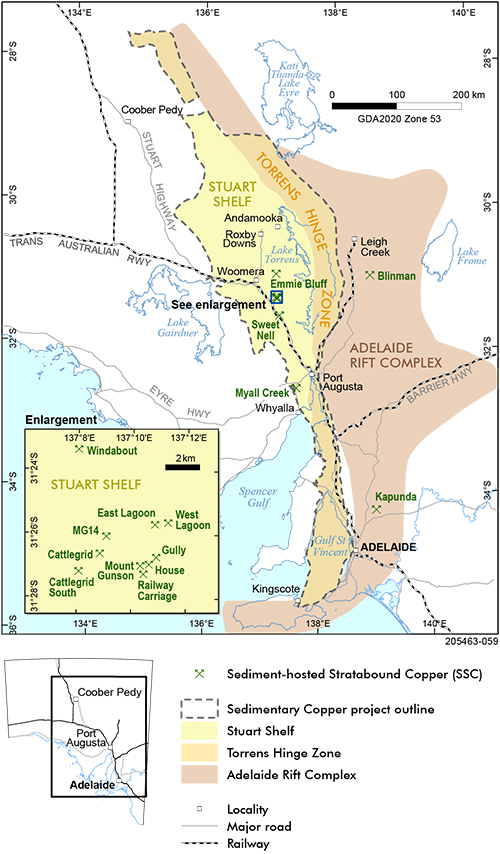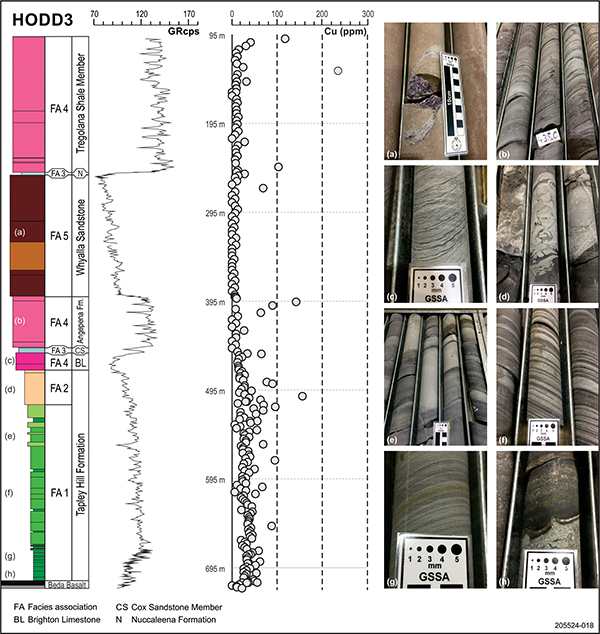Applying basin analysis to de-risk exploration of the Stuart Shelf.
To support industry interest in sediment-hosted stratabound copper (SSC), the Geological Survey of South Australia (GSSA) and CSIRO’s Sediment-Hosted Mineral Systems research team are advancing the framework for future discoveries through a collaborative project. The project will provide fundamental datasets and understanding that will help explorers target SSC deposits in South Australia.
The Neoproterozoic sedimentary succession of the Adelaide Rift Complex and Stuart Shelf have long been considered as having potential for significant SSC resources due to similarities with the world-class Zambian Copperbelt and Polish Kupferschiefer. Both the Adelaide Rift Complex and Stuart Shelf have numerous SSC deposits and occurrences (Fig 1).
Figure 1 Sediment-hosted stratabound copper deposits within the Stuart Shelf and the Adelaide Rift Complex.
SSC deposits are characterised by disseminations, cements and lesser veinlet-hosted copper minerals that are peneconformable (nearly conformable) with their sedimentary or metasedimentary host rocks (Hayes et al. 2015). Deposits are typically thin (<50 m) but laterally extensive (several kilometres) supporting SSC deposits as the second most important source of copper in the world after porphyry copper deposits (Hammarstrom et al. 2019).
The project aims to improve knowledge of the Stuart Shelf basin architecture and distribution, thickness and depth of key lithostratigraphic units within the Neoproterozoic and underlying basin successions – key controls on the likely occurrence and location of sedimentary copper mineralisation.
Through a comprehensive screening process, 25 drillholes from across the Stuart Shelf have been selected as the foundation for the basin analysis. The drillholes are being logged in detail and gamma and portable X-ray fluorescence readings taken alongside to provide consistent and comparable datasets for a basin-wide sequence stratigraphic correlation (Fig 2).
Figure 2 Drill core log summary, handheld gamma and portable XRF data for drillhole HODD3 (SA Geodata drillhole 268313). (a) Fluorite vein in massive medium-grained sandstone of the Whyalla Sandstone. (b) Typical sandflat facies of the Angepena Formation: laminated to flaser bedded to ripple cross-bedded siltstones and very fine- to fine-grained sandstones with rip-up clasts and soft sediment deformation. (c) Microbiolaminites of the Brighton Limestone. (d) Light grey dolomite clast conglomerates (edgewise conglomerates) within dark grey siltstone and intercalated dark grey and light grey dolomitic siltstones to very fine grained sandstone within the upper part of the Tapley Hill Formation. (e) Intercalated thin dark grey siltstones and thick (>5 cm) light grey dolomitic siltstones characteristic for the middle and upper part of the Tapley Hill Fm. (f) Millimetre to <1 cm thick intercalated dark siltstone and light dolomitic grey siltstones characteristic for the lower to middle part of the Tapley Hill Formation. (g) Disseminated pyrite within laminated siltstones in the lower part of the Tapley Hill Formation. (h) Basal contact of the Tapley Hill Formation with the underlying Beda Basalt.
Upcoming workshop and drill core display
To aid industry in understanding and gaining the most from this project the GSSA and CSIRO are hosting a workshop and core viewing session in conjunction with the GSSA Discovery Day in late November 2021.
The workshop on 24 November (in person and online) will review the state of current knowledge on SSC mineral systems and discuss new insights from recent investigations on the Stuart Shelf. Presentations will include:
- review of SSC mineralisation in South Australia and its global context
- basin analysis: providing a framework for discovery
- stratigraphy and lithofacies of the Stuart Shelf
- potential source rocks in the Stuart Shelf
- current project updates on exploration in the Stuart Shelf and adjacent areas from industry.
The core viewing session on 23 November will showcase a north–south transect across the main basin and basement units of the Stuart Shelf. Registrations for this in person event at the South Australia Drill Core Reference Library are currently full – we will advertise any spaces that become available on the GSSA LinkedIn page.
Keep up to date with the Sedimentary Copper Mineral Systems of the Stuart Shelf project
References
– Carmen Krapf and Adrian Fabris, October 2021




